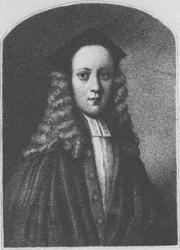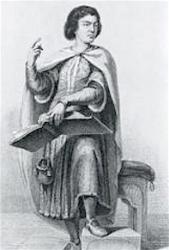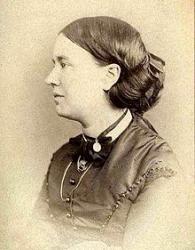Planning worship?
Check out our sister site, ZeteoSearch.org,
for 20+ additional resources related to your search.
- |
User Links
Person Results
‹ Return to hymnal





Export as CSV
John Byrom

1692 - 1763 Meter: 10.10.10.10.10.10 Hymnal Number: 133 Author of "Christians, Awake!" in Hymns to the Living God John Byrom was born in 1691, at Manchester, where his father was a linen-draper. He entered Trinity College, Cambridge, 1708; became a Fellow of the College in 1714; took his M.A. in 1716, and then proceeded to Montpelier, where he studied medicine. He afterwards abandoned medicine, settled in London, and obtained his living by teaching a system of shorthand, which he had projected. He was elected a member of the Royal Society in 1724. He died Sept. 28, 1763. The first edition of Byrom's poems appeared in 1773, in two volumes. A more complete edition was published in 1814. Byrom did not seek publicity as an author, but wrote verses only for recreation.
--Annotations of the Hymnal, Charles Hutchins, M.A., 1872
======================
Byrom, John, M.A., F.R.S., born at Manchester, Feb. 29,1691-2, baptized the same day, and educated at Merchant Taylors' School, and Trinity College, Cambridge, where he graduated B.A. 1712 ; M.A. 1715. He was elected a Fellow of his College in 1714. After studying medicine for a time at Montpellier, he returned to London, and earned his livelihood by teaching shorthand. Elected F.R.S. in 1724, and succeeded to the family estates about the same time. He died Sept. 28, 1763. His Poems were first published in 1773, in two volumes. In 1814 a more complete edition was issued by Nichols, of Leeds. From these Poems less than half a dozen hymns have come into common use. One of these, however, has a repu¬tation which has extended to all English-speaking countries. We refer to his "Christians, awake!" (q.v.). His hymn, "My spirit longeth for Thee," is also worthy of attention.
-- John Julian, Dictionary of Hymnology (1907)
John Byrom
Kathrina von Schlegel
1697 - 1797 Person Name: Katrina A. D. von Schlegel Meter: 10.10.10.10.10.10 Hymnal Number: 308 Author of "Be Still, My Soul" in Hymns to the Living God Schlegel, Catharina Amalia Dorothea von. Little is known of this lady. According to Koch, iv., p. 442, she was born Oct. 22, 1697, and was "Stiftsfräulein" in the Evangelical Lutheran Stift (i.e. Protestant nunnery) at Cöthen. On applying to Cöthen, however, her name did not occur in the books of the Stift; and from the correspondence which she carried on, in 1750-52, with Heinrich Ernst, Count Stolberg, it would rather seem that she was a lady attached to the little ducal court at Cöthen. (manuscript from Dr. Eduard Jacobs, Wernigerode, &c.) Further details of her life it has been impossible to obtain.
The only one of her hymns which has passed into English is:—
Stille, mein Wille, dein Jesus hilft siegen. Cross and Consolation. A fine hymn on waiting for God. It appeared in 1752, as above, No. 689, in 6 stanzas of 6 lines; and is included in Knapp's Evangelischer Lieder-Schatz, 1837, No. 2249 (1865, No. 2017). The translation in common "Be still my soul!—-the Lord is on thy side." This is a good translation, omitting stanzas iii., by Miss Borthwick, in Hymns from the Land of Luther, 2nd Ser., 1855, p. 37 (1884, p. 100). [Rev. James Mearns, M.A.]
--Excerpts from John Julian, Dictionary of Hymnology (1907)
Kathrina von Schlegel
John Wainwright
1723 - 1768 Meter: 10.10.10.10.10.10 Hymnal Number: 133 Composer of "YORKSHIRE" in Hymns to the Living God John Wainwright United Kingdom. He published a collection of Psalm tunes, anthems, chants, and hymns. A talented musician, the following year he was appointed organist and singer at Manchester Collegiate Church (later the Manchester Cathedral). His son, Robert, succeeded him as organist after he died.
John Perry
John Wainwright
Jean Sibelius

1865 - 1957 Meter: 10.10.10.10.10.10 Hymnal Number: 308 Composer of "FINLANDIA" in Hymns to the Living God Johann Julius Christian [Jean] Sibelius DM Finland 1865-1957. Born at Hameenlinna, Finland, the son of a Swedish-speaking medical doctor, he lost his father to typhoid in 1868, leaving the family in substantial debt. His mother, again pregnant, had to sell their property and move in with her widowed mother. His aunt Julia gave him piano lessons when he was seven on the family upright piano, wrapping him on the knuckles when he played a wrong note. He learned to improvise as he played. His uncle, Pehr Ferdinand Sibelius, was interested in music, especially the violin, and gave Jean a violin when he was 10. As his musical advisor his uncle encouraged him to play and compose music. He played music with sister on piano, brother on cello, and himself on violin. He attended a Finnish-speaking prep school in 1874 and continued his education at the Hameenlinna Normal Lyceum thereafter. Jean also showed a strong interest in nature, frequently walking around the countryside when the family moved to the Loviisa coast for the summer months. In 1881 he took violin lessons from the local bandmaster, and developed a strong interest in violin. He became an accomplished player, and thought of becoming a virtuoso, but realizing he began study too late in life for that, instead opted to compose. He often played music in quartets with neighboring families, adding to his chamber music experience. He took the French form of his name, Jean. He studied law at the Imperial Alexander University in Finland, but showed far more interest in music. He then studied music at the Helsinki Music Institute (now Sibelius Academy) from 1885-1889. The school’s founder, Martin Wegelius, did much to support education development in Finland and gave Sibelius his first lessons in composition. Another teacher,,Ferruccio Busoni, a pianist-composer, helped him as well and became a life-long friend. Other friends, pianist Adolf Paul, and conductor-to-be, Armas Jarnefelt, also helped him. In 1892 he married Armas ‘s sister, Aino Jarnefelt, daughter of General Alexander Jarnefelt, governor of Vaasa. They had six daughters, Eva, Ruth, Kirsti, Katarina, Margareta, and Heidi. He continued his musical studies in Berlin (1889-1890) with Albert Becker, and in Vienna (1890-1891) with Robert Fuchs and Karl Goldmark. In Berlin he had opportunity to attend concerts and operas. In Vienna he turned to orchestral composition and had much success, although he had gallstone surgery during that period. He also traveled to the UK, France, Germany, and the USA during this time in his life, composing, conducting, and socializing. In 1892 he took on teaching assignments at the Music Institute and at Kajanus’s conducting school, but this left him with little time for composing. Sibelius’ works were more and more appreciated in Helsinki concert halls as he composed and conducted symphonies in the mid-1890s. In 1898 he was awarded a substantial grant, initially for 10 years, and later extended for life, allowing him to concentrate on composition. Much of his music became popular in Finland and in Germany. In 1899 he began work on his first symphony. It went well, but other patriotic music hehad composed did even better, since Russia was trying to restrict the powers of the Grand Duchy of Finland. In 1900 Sibelius went on an international tour with Kajanus and his orchestra, presenting his recent works. In 1901 he wrote his second symphony, which received rave reviews. He continued to compose as he became popular and well-known. In 1903 he had a new home built near Lake Tuusula north of Helsinki, calleed Ainola (after his wife). He gave concerts in and around Finland, spending more and more time away from home, to the chagrin of his wife. After a time he returned home and composed from there. He spent much time wining and dining in Helsinki, and it had a disastrous effect on his wife, who finally entered a sanitorium. He resolved again to give up drinking and concentrate on composing his 3rd symphony. He met Gustav Mahler in Helsinki and they became friends. He performed his 3rd symphony in St Petersburg, Russia. In 1907 he underwent a serious operation for suspected throat cancer, and spent time in the hospital in 1908. His smoking and drinking had now become life-threatening. He cancelled concerts for Rome, Warsaw, and Berlin, but kept one in London. His health deteriorated further, And his brush with death inspired him to compose his 4th symphony. In 1909 his successful throat operation resulted in renewed happiness for him and his wife, Aino. He continued conducting concerts, and met Claude Debussy, who further encouraged his musical efforts. He began working on his 4th symphony in 1910, but had to write other music to compensate for dwindling funds. He finished his 4th symphony in Berlin and conducted concerts in Sweden in 1911. In 1912 he completed short orchestral works. Over the next several years he continued producing a variety of pieces of music, well-received, especially in America. He was given an honorary DM degree from Yale University and also another from the University of Helsinki about the same time. WW1 interrupted his music royalties in 1915, and he was forced to compose smaller works for publication to make ends meet. He completed his 5th symphony at age 50, but he was dissatisfied with it and reworked it three times In 1917 he starting drinking again, triggering arguments with his wife. The Russian Revolution in 1917 caused an improvement in their personal relationship, and he wrote his ‘Jager March’ to celebrate Finnish independence from Russia. The next year the Finnish Civil War began, putting a damper on his march. In 1919, after the war, he completed his 6th symphony. In 1920 George Eastman , of Eastman Kodak, asked him to teach for a year in New York, but he declined. He did enjoy a trip conducting several concerts in England in 1921. He premiered his 6th symphony in 1923. In 1924 he completed his 7th symphony. The next year he composed a number of small pieces. He began drinking again. He did write a few more major works, but for the last thirty years of his life he avoided publicly talking about his music. He tried to write an 8th symphony, but was unsatisfied with it and burned the scores. In fact, he burned a laundry basket full of music he had written, to the chagrin of his wife. But, afterward, he became calmer and gradually had a lighter mood. In 1935 he was awarded the Goethe-Metal, with a certificate signed by Adolf Hitler. A Soviet invasion of Finland in 1939 was repelled, but Finland gave up territory to Russia as a result. In 1941 Sibelius and his wife returned to their Finland home, Ainola, after a long absence. He did not compose much the last few years, and died at Ainola. His wife outlived him by 12 years.
John Perry
Jean Sibelius
David Hugh Jones
1900 - 1983 Meter: 10.10.10.10.10.10 Hymnal Number: 308 Arranger of "FINLANDIA" in Hymns to the Living God David Hugh Jones (1900-1983)
Born: 1900, Jackson, Ohio.
Jones attended the Guilford Organ School, New York City (graduated 1920), and the American Conservatory, Fontainebleau, France, and received honorary degrees from Washington and Jefferson, and Beaver Colleges. In 1924, he became a Fellow of the American Guild of Organists. He played the organ at churches in Portsmouth and Dayton, Ohio; and in New York City, Rome, and Brooklyn, New York. From 1934 until retiring in 1979, he was the Miller Chapel organist and choir director at Princeton Theological Seminary, New Jersey. In 1937, he founded the seminary’s touring choir, which sang at thousands of churches in America, Canada, Cuba, Mexico, Colombia, Venezuela, the Caribbean islands, Japan, and Korea.
--www.hymntime.com/tch/
David Hugh Jones
George Croly

1780 - 1860 Meter: 10.10.10.10 Hymnal Number: 199 Author of "Spirt of God, Descend upon My Heart" in Hymns to the Living God Croly, George, LL.D., born in Dublin, Aug. 17, 1780, and educated at the Dublin University (M.A. 1804, LL.D. 1831). After taking Holy Orders, he laboured in Ireland till about 1810, when he took up his residence in London, and devoted himself to literature. In 1835 he succeeded to the united benefices of St. Stephen's, Walbrook, and St. Benet Sherehog, retaining the same till his death, which occurred suddenly in the public street, Holborn, Nov. 24, 1860. His prose publications, in addition to contributions to Blackwood's Magazine, were numerous, and dealt with biographical, historical, and scriptural subjects. His hymns were given in his—
Psalms and Hymns for Public Worship. Written and compiled by the Rev. George Croly, LL.D. London Kendrick, 1854.
This collection contained 25 psalms, 50 hymns, and 6 poems. Of these 10 psalms, 12 hymns, and the 6 poems bear Dr. Croly's initial. The following have come into common use mainly through Windle's Collection:—
1. Be still, be still, impatient soul. Patience.
2. Behold me, Lord, and if thou find. Lent.
3. Lift up your heads, ye gates of light. Ascension.
4. Lord, who hast sought us out, unsought. Public Worship.
5. Teach us, O Lord, this day. Sunday.
6. Thou, Lord of mercy and of might. Lent.
All these date from 1854, with the exception of No. 6, which appeared in his Scenes from Scripture and other Poems, 1851.
-- John Julian, Dictionary of Hymnology (1907)
George Croly
Peter Abelard

1079 - 1142 Person Name: Peter Abelard, 12th cent. Meter: 10.10.10.10 Hymnal Number: 341 Author of "Oh, What Their Joy and Their Glory Must Be" in Hymns to the Living God Abelard, Peter, born at Pailais, in Brittany, 1079. Designed for the military profession, he followed those of philosophy and theology. His life was one of strange chances and changes, brought about mainly through his love for Heloise, the niece of one Fulbert, a Canon of the Cathedral of Paris, and by his rationalistic views. Although a priest, he married Heloise privately. He was condemned for heresy by the Council of Soissons, 1121, and again by that of Sens, 1140; died at St. Marcel, near Chalons-sur-Saône, April 21, 1142. For a long time, although his poetry had been referred to both by himself and by Heloise, little of any moment was known except the Advent hymn, Mittit ad Virginem, (q.v.). In 1838 Greith published in his Spicihgium Vaticanum, pp. 123-131, six poems which had been discovered in the Vatican. Later on, ninety-seven hymns were found in the Royal Library at Brussels, and pub. in the complete edition of Abelard's works, by Cousin, Petri Abelardi Opp., Paris, 1849. In that work is one of his best-known hymns, Tuba Domini, Paule, maxima (q.v.). Trench in his Sacra Latina Poetry, 1864, gives his Ornarunt terram germina (one of a series of poems on the successive days' work of the Creation), from Du Meril's Poesies Popul. Lat. du Moyen Age, 1847, p. 444.
-John Julian, Dictionary of Hymnology (1907)
Peter Abelard
Frederick C. Atkinson
1841 - 1896 Person Name: Frederick C. Arkinson Meter: 10.10.10.10 Hymnal Number: 199 Composer of "MORECAMBE" in Hymns to the Living God Born: August 21, 1841, Norwich, Norfolk, England. Died: November 30, 1896, East Dereham, Norfolk, England. As a boy Atkinson was a chorister and assistant organist at Norwich Cathedral. In 1867 he graduated with a Bachelor of Music degree from Cambridge and then served as organist and choirmaster in St. Luke's Church, Manningham, Bradford. He also held that position at Norwich Cathedral and at St. Mary's Parish Church in Lewisham. Atkinson wrote hymn tunes, anthems, and complete Anglican services, as well as songs and piano pieces.
Psalter Hymnal Handbook, 1988
Frederick C. Atkinson
James Langran
1835 - 1909 Meter: 10.10.10.10 Hymnal Number: 316 Composer of "LANGRAN" in Hymns to the Living God James Langran (b. St. Pancras, London, England, November 10, 1835; d. Tottenham, London, England, June 8, 1909) studied organ as a youth but did not receive his Bachelor of Music degree from Oxford until he was forty-nine years old. He had several organist positions–the longest was at St. Paul's Church, Tottenham, England, from 1870 to 1909. He also taught music at St. Katherine's Training College for Schoolmistresses (1878-1909). Music editor of theNew Mitre Hymnal (1875), Langran composed around fifty hymn tunes and contributed several of them to early editions of Hymns Ancient and Modern.
Bert Polman
James Langran
Jean Ingelow

1820 - 1897 Meter: 10.10.10.6 Hymnal Number: 221 Author of "I Sought the Lord" in Hymns to the Living God Ingelow, Jean, daughter of W. Ingelow, Boston, Lincolnshire, was born in 1820. Her writings are well and favourably known. Her poetical pieces have been published as Poems, 1863, and A Story of Doom and other Poems, 1867. From her Poems, 1863, the cento "And didst Thou love the race that loved not Thee" (Love of Christ in the Congregational Church Hymnal 1887, is taken.
--John Julian, Dictionary of Hymnology, Appendix, Part II (1907)
===============
Born: March 17, 1820, Boston, Lincolnshire, England.
Died: July 20, 1897, Kensington, London, England.
Buried: Brompton Cemetery, London, England.
A well known 19th Century poet, Ingelow’s works include:
A Rhyming Chronical of Incidents and Feelings, 1850
Poems, 1863
A Story of Doom and Other Poems, 1867
Mopsa the Fairy
One of her more popular poems was "O Fair Dove, O Fond Dove."
--www.hymntime.com/tch
Jean Ingelow


 My Starred Hymns
My Starred Hymns


